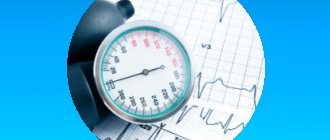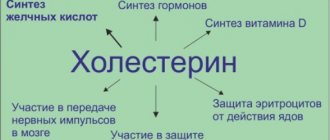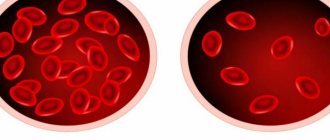What is systolic pressure and what does it determine?
Blood pressure (BP) numbers are determined by two indicators: systolic upper SBP, diastolic lower DBP.
Measured with a tonometer in millimeters of mercury (mmHg). For a healthy adult, the norm is 120/80 mmHg. up to 100/70 mmHg Low numbers may be a variant of the norm if such pressure is observed throughout life and is “working”. The exception is situations of sudden or prolonged decrease in blood pressure and deterioration of general condition, which may indicate pathology of the heart, kidneys, psycho-emotional fatigue, metabolic disorders, and hormonal imbalance. To understand the problem of low systolic pressure with constant normal diastolic pressure, you need to understand what this condition may indicate.
Upper pressure is the moment the heart chambers contract and blood is pushed through the arteries during systole. Low upper pressure may indicate congenital or acquired cardiac pathology, which is taken into account when prescribing an examination plan, treatment regimen and further monitoring of the patient.
What pressure is considered normal?
Blood pressure is divided into two indicators:
- upper (systolic) - it indicates the pressure of blood moving in the direction from the heart to the aorta and speaks of vascular resistance;
- lower (diastolic) - speaks of the strength of the blood, which returns to the heart, which is in a calm state and approaches the vena cava.
The average difference between the two blood pressure readings is 30–40 mmHg, with a blood pressure of 120/80 considered normal. Fluctuations in one direction or another, which do not affect a person’s well-being, are not considered pathological, therefore a tonometer reading of 115/75 mm Hg is not a reason for panic. There are some nuances to setting a normal blood pressure threshold.
Thus, blood pressure in older people is often higher than in middle-aged patients - this is explained by physiological changes that occur in the body over the years. Blood pressure indicators change when a person’s psychological state changes, after drinking strong tea or coffee, or after active physical activity, but at the same time it returns to normal on its own, without changing the state of health. A decrease in diastolic pressure on a regular basis indicates the development of hypotension; the same diagnosis is made to the patient if both blood pressure values - lower and upper - are constantly recorded below normal.
Reasons why the upper figure may decrease
In the modern rhythm of life, factors such as stress, insufficient rest during intense workload, psycho-emotional experiences, and untimely treatment of underlying diseases lead to a decrease in blood pressure.
Other causes of low upper blood pressure are listed below:
Vegetative-vascular dystonia of the hypotonic type.- Pregnancy period, especially the first trimester, and in patients with severe toxicosis.
- Hormonal disorders, diabetes, hypothyroidism, adrenal insufficiency.
- Consequences of injuries to the head, neck, spine.
- Physical fatigue, especially among professional athletes.
- Congenital or acquired cardiac pathology, valve defects, incorrect selection of medications for hypertension.
- Neurosis, depressive disorder, chronic fatigue syndrome.
- Frequent changes in time zones and climate.
- Sudden change of weather.
- Dehydration, fatigue, consequences of infectious diseases, injuries, operations, blood loss.
Reduced systolic with normal diastolic: why does this happen?
Upper pressure decreases as cardiac contractility decreases. This can happen when:
- damage to the heart and large vessels due to atherosclerosis, rheumatism;
- decreased vascular tone;
- heart failure;
- dysfunction of the autonomic nervous system;
increased secretion of the hormone acetylcholine and decreased adrenaline;- taking sedatives that slow your heart rate.
However, it should be remembered that it is almost impossible to distinguish low systolic pressure from high diastolic pressure on your own. A single measurement of blood pressure at home is not enough to make a correct diagnosis. Cardiologists, therapists and neurologists focus patients’ attention on the need for examination by a specialist. Within the walls of a medical institution, special instrumental diagnostics are carried out to detect low SBP.
Factors influencing the decrease in pressure
There are 3 main factors that influence the pressure indicator:
- cardiac output (the rate at which blood flows out of the heart);
- volume of blood in the blood vessels (low amount of blood in the body is called hypovolemia and leads to hypotension).
- parameters of blood vessels (their internal diameter, wall density).
Heart pressure changes throughout the day and depends not only on the above factors, but also on the age and body type of the person. Low heart pressure that is asymptomatic in healthy, active people is considered natural and does not require treatment.
Low blood pressure sometimes occurs in young people
But if small tonometer readings are accompanied by the above unpleasant symptoms, then it is likely that the following reasons provoked hypotension:
- dehydration due to loss of fluid or excessive sweating in very hot weather;
- overdose of drugs used to treat hypertension, angina, depression;
- pulmonary embolism, weakening of the heart muscle after a heart attack;
- anemia (reduced number of red blood cells or lack of hemoglobin, the red blood cells that carry oxygen throughout the body);
- Addison's disease, or dysfunction of the adrenal glands, which normally secrete hormones involved in blood pressure control;
- pregnancy;
- immobility (bed rest for a long period due to illness or injury);
- significant blood loss;
- septic shock (acute infection).
How to solve the problem?
If low SBP is caused by chronic fatigue, insufficient rest or emotional distress, to improve the condition, taking vitamins and sedatives based on Valerian, Motherwort, Peppermint and Melissa is indicated to normalize night sleep. For neurological disorders, B vitamins with Magnesium and ascorbic acid are recommended. However, it should be understood that such treatment is more preventive and cannot eliminate hypotension. Without a doctor's examination, it is impossible to independently identify the true cause of the disorder and raise the upper pressure. Alternative therapy for low systolic blood pressure is not recommended, since taking such medications can mask the manifestations of hypotension, while the underlying cause of the disease will not be identified.
Diagnostic methods
All patients with low blood pressure undergo:
- Electrocardiogram to assess heart rhythm and detect bradycardia.
- Three-time measurement of blood pressure on both arms to assess the difference in pressure, counting heart rate and pulse.
- Holter 24-hour monitoring. Allows you to identify peaks of the lowest and highest SBP over a period of 24 hours, and other deviations.
- Ultrasound with Doppler, Echocardiography. Evaluates the condition of the cavities of the heart, large and small vessels, blood flow, and the functioning of the valve apparatus.
- Listening to the work of the heart with a phonendoscope.
Additionally, laboratory diagnostics are carried out: clinical blood and urine tests, hormones taking into account symptoms, biochemical markers of the lipid spectrum, kidney and liver tests.
What drug therapy is most often prescribed in such a case?
With low upper pressure, treatment is prescribed after receiving the conclusions of all examinations. It is extremely important to identify the cause of the disorder in order to choose the right treatment regimen.
Currently, the following are indicated to raise blood pressure:
| 1. | Medications. | Caffeine, Pantocrine, Citramon, Etilephrine, Rodeola tinctures, Leuzea. |
| 2. | Dosed physical activity. | Walking, stretching, jogging, gentle exercise 30 minutes a day. |
| 3. | Physiotherapy. | Cryomassage, acupuncture, magnetic therapy. |
| 4. | Rejection of bad habits. | Smoking, alcohol, energy drinks. |
| 5. | Normalization of work schedule, sleep and rest, nutrition. | Night sleep is at least 8 hours, daytime sleep is 30 – 60 minutes. Airing the room before going to bed. |
Drug treatment regimens include:
For vegetative-vascular dystonia, take general strengthening and tonic drugs based on herbal components, caffeine, tinctures from the roots of Ginseng, Schisandra.- For chronic fatigue and depressive disorder, antidepressants, sedatives, and sleeping pills are indicated to correct persistent insomnia.
- To improve blood flow, massage of the body, neck, and head is recommended.
- For diabetes, glycemic control, regular use of glucose-lowering drugs are indicated, and for hormonal disorders, appropriate hormone therapy.
- If another concomitant pathology causing hypotension is detected, pathogenetic therapy is prescribed.
How to raise upper blood pressure, what can you take?
You can increase blood pressure at home thanks to medications and traditional medicine.
Medicines that increase blood pressure:
If you have nausea, vomiting, impaired consciousness, or feel very weak, it means your hypotonic crisis is progressing. This condition is very dangerous, but you can prevent it. Doctors recommend taking the following medications first:
- Citramon
- Aspirin
- Dobutamine
Follow the instructions and take the medicine strictly following them. If you don’t have pills at home, then traditional medicine will help you.
Use medications and folk remedies
Folk remedies that increase blood pressure:
To increase your upper blood pressure, take one of the following:
- A product made from ginger root, natural honey and lemon juice.
- Tea made from angustifolia fireweed. Drink this drink adding a little honey. It neutralizes the ability of this drug to thicken the blood.
- A product made from lemon juice, honey and coffee beans.
- A remedy made from celery root.
- Juice from aloe leaves.
How does a constant decrease in SBP affect the patient's life prognosis?
The prognosis for low upper pressure is determined by the cause of hypotension. In the absence of serious concomitant cardiac pathology, kidney disease, or endocrine disorders, the prognosis is relatively favorable.
If low SBP is detected before the age of 25 years, there is a high probability of normalizing blood pressure using lifestyle correction. At older ages, patients are recommended to undergo a more thorough examination by a cardiologist, therapist and neurologist, drug therapy and physiotherapy.
Normalization of indicators
If there is a constant decrease in blood pressure, you should contact a cardiologist or therapist for a general diagnosis. Most often, treatment is based on preventive methods and is rarely supplemented with drug therapy. Help normalize low blood pressure:
- caffeine;
- strong tea;
- cold and hot shower;
- healthy sleep;
- proper nutrition;
- morning exercises.
The following drugs are effective:
- "Citramon";
- "Heptamil";
- "Regulton".
The use of any tablets to increase blood pressure should be done only after consultation with the attending cardiologist.
conclusions
Hypotension is determined when the pressure drops below 120/80 mmHg; it can be either normal or pathological. There are possible cases when only one indicator decreases - SBP, while the upper pressure is low and the lower pressure is normal. Symptomatically manifested by general weakness, increased fatigue, attacks of headache and dizziness. Often occurs after physical or psycho-emotional fatigue. It may be a sign of a cardiac or concomitant disease, and requires a comprehensive examination. Based on the conclusion, the doctor prescribes drug therapy and gives recommendations on normalizing the daily routine and rest.
Types of hypotension
Reduced diastolic blood pressure (hypotension) is divided into several types:
- Orthostatic hypotension. This diagnosis can be made to an elderly person, since this condition is provoked by age-related changes in the body. A decrease in diastolic pressure can be observed during sudden movements - lifting or bending, when blood quickly flows into the limbs. However, with an immediate decrease in pressure, the heart continues to work at the same rhythm, despite the presence of weakness, loss of balance, or even fainting.
- Vegetovascular hypotension. It is observed more often in adolescents, when the nervous and cardiovascular systems are not yet fully formed, and the brain receives incorrect commands. If a command was given to increase the pressure, it decreases.
- Postprandial hypotension. This type of hypotension is manifested by a decrease in blood pressure after eating. The heart does not accelerate as the blood moves downward, there is no vasoconstriction, and the patient feels a sharp rush to the legs.
If diastolic pressure is reduced, but a high pulse is recorded, this condition is considered potentially dangerous. It indicates that the heart pumps blood with effort, and its passage through the capillaries occurs with difficulty.
Should low blood pressure be treated?
Many people do not feel the rise and fall of their blood pressure. This is how our body works - it adapts to moderate changes in blood pressure thanks to complex internal mechanisms. However, this does not mean that such conditions are not dangerous.
Everyone knows that arterial hypertension is often accompanied by strokes and heart attacks. However, not many people know that hypotension has the same complications!
And low blood pressure in youth can lead to arterial hypertension in adulthood and old age. Therefore, hypotension is an absolutely real problem. For older people, hypotension is completely dangerous: the brain suffers from a lack of oxygen and nutrients (coupled with atherosclerosis, an ischemic stroke can develop), and heart disease (atherocardiosclerosis and angina) progresses more rapidly with hypotension.
For pregnant women, low blood pressure is an extremely dangerous condition. The fetus does not receive enough nutrients and oxygen (as a result, congenital malformations occur, and premature birth or miscarriage are possible.
Symptoms of low blood pressure:
- dizziness, loss of consciousness, weakness, decreased memory, attention, performance,
- headache (in the temples, forehead),
- tachycardia (rapid heart rate),
- pain in the heart area (lasts more than 30 minutes),
- nausea, vomiting, flatulence, constipation.
To establish the cause of these symptoms and make a diagnosis, further examination (ECG, ultrasound of the heart and blood vessels, FGDS) and consultation and observation of doctors (therapist, endocrinologist, neurologist, gastroenterologist) are necessary.











